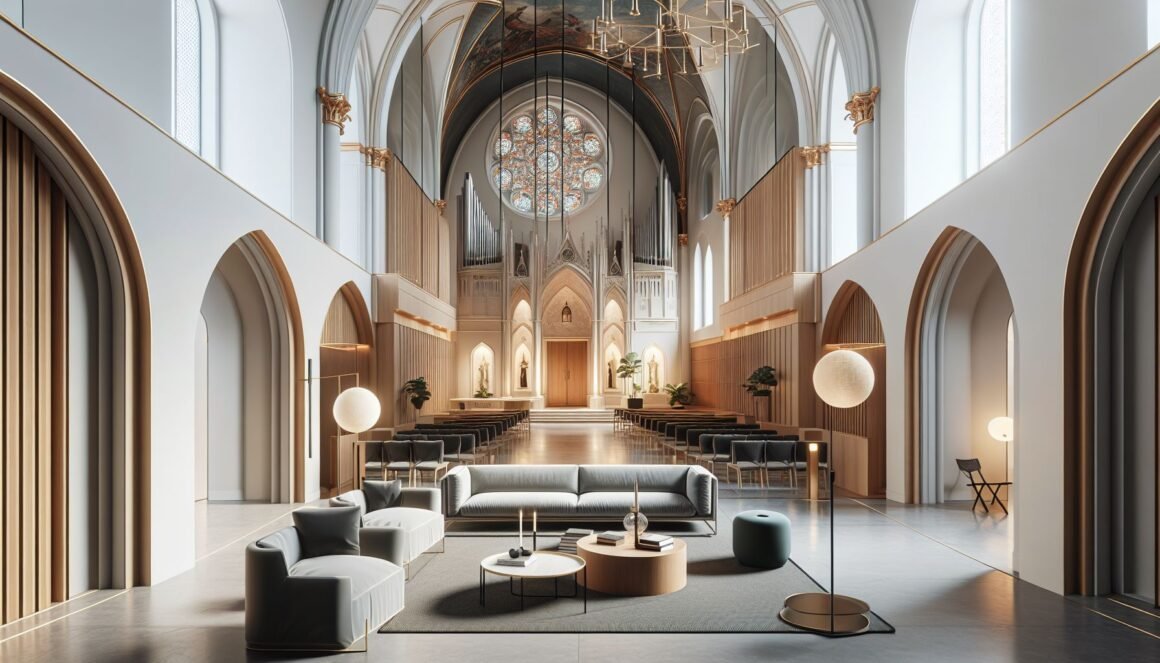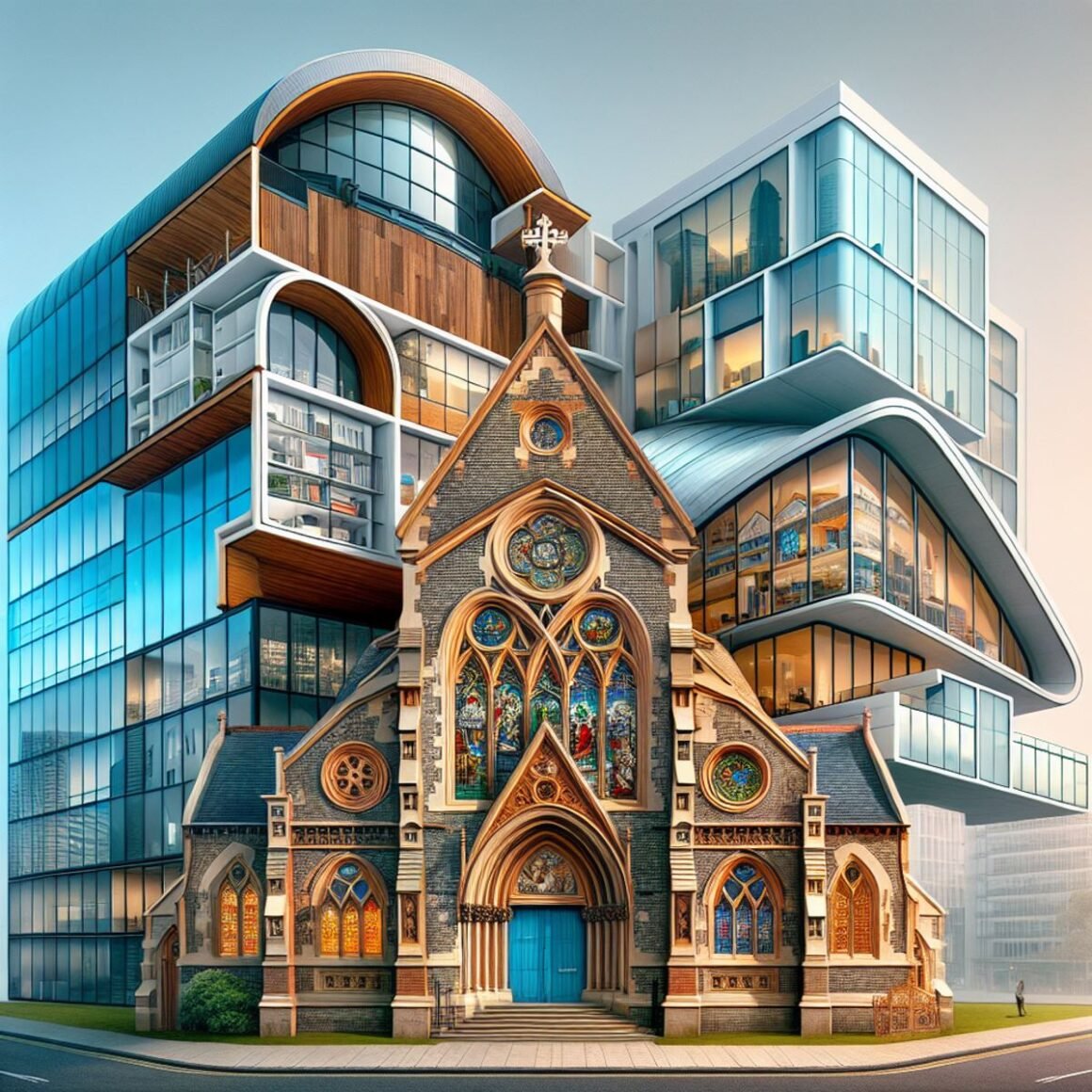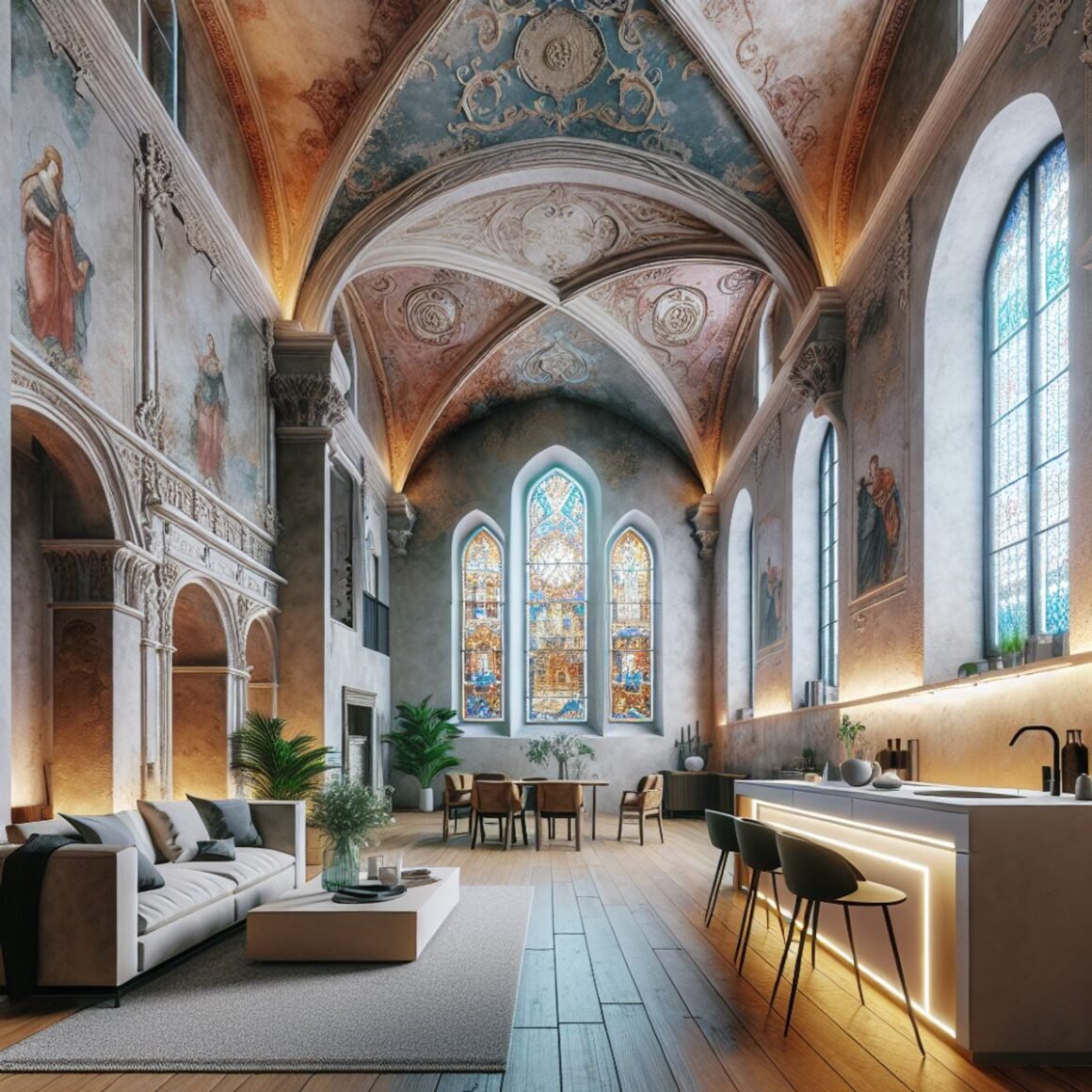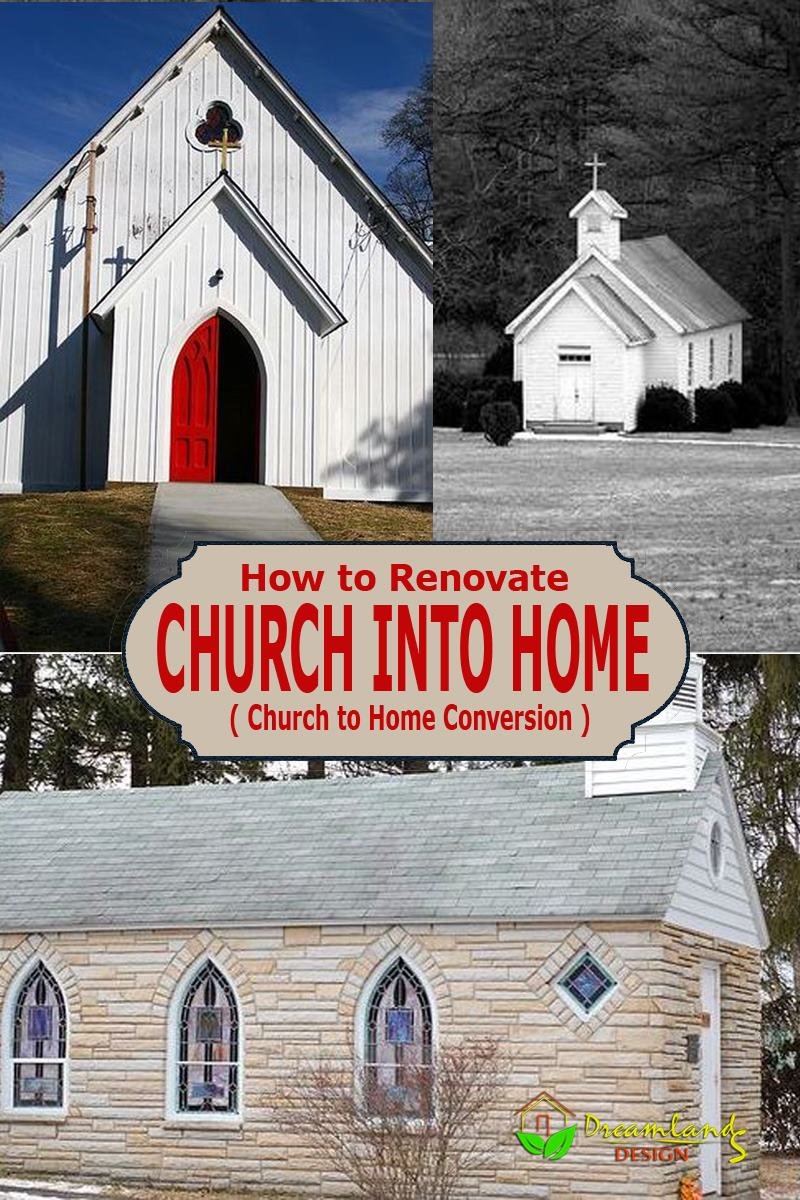Table of Contents Show
Introduction
There’s a certain kind of magic in repurposing old, historic buildings into something new and functional. One trend that is gaining momentum in the world of architecture is the conversion of churches into homes. These sacred spaces, steeped in history, are finding new life as unique residences.

Church conversions offer a slew of benefits. For starters, they provide ample space and high ceilings—an interior design dream! Plus, who wouldn’t want to live in a building with its own bell tower or grand stained-glass windows? Not to mention, owning a piece of history carries its own charms.
But converting a church to a home isn’t just about aesthetics. It’s also about preserving architectural heritage and breathing new life into structures that might otherwise fall into disrepair.
Yet, this path is not without its challenges. The very features that make churches alluring—vaulted ceilings, for example—can pose significant hurdles when it comes to heating, cooling, and acoustics. The open nature of these spaces can also make privacy tricky. And then there’s navigating the maze of permits and approvals, particularly for heritage structures.
Fortunately, with careful planning and creative design solutions, these obstacles can be overcome. In fact, some have turned their church conversion projects into real masterpieces (similar to how shipping containers have been used in modern architecture). Incorporating elements like shipping containers into church conversions has become increasingly popular due to their versatility and cost-effectiveness.
So, why not explore the captivating world of church conversions? This guide will walk you through everything you need to know—from the initial planning stages to overcoming common challenges—all the way to taking inspiration from successful projects around the globe where shipping containers have been converted into tiny homes.
Ready? Let’s dive in!
1. The Process of Converting a Church to a Home
Turning an old church into your new home? Well, it’s not a Sunday School project. Just as with any historic home renovation process, this requires serious planning and meticulous execution. But don’t get scared off yet. We’re here to walk you through the main steps of this heavenly transformation.
Thorough Planning
The first and one of the most crucial steps in any renovation project is thorough planning. This involves setting a realistic budget and timeline for the transformation of your church into a home.
Setting a Budget
When it comes to budgeting, it’s important to remember that you’re not dealing with just any old building; this is a historical treasure. As such, the restoration costs can be higher than standard remodeling projects. It’s not just about giving the place a fresh coat of paint or changing the floors. You might have to deal with:
- Structural repairs: Weathered stones might need fixing, or old wooden beams might require reinforcement.
- Special materials: Preserving historical integrity often involves sourcing special materials that match the original structure.
- Professional expertise: Experts in heritage restoration can charge more due to their specialized skills.
Thus, it’s advisable to set aside a generous budget for unexpected expenses that may arise during the process.
Crafting a Timeline
As for the timeline, remember this adage: Rome wasn’t built in a day. Similarly, your church-home conversion will need time. The exact timeframe will depend on various factors like:
- The size and condition of the property
- The complexity of your renovation plans
- The speed at which permits are approved
- The availability and schedule of contractors
It’s key to be patient during this process; rushing could lead to mistakes and additional costs.
In conclusion, thorough planning is essential when embarking on a church-to-home conversion project. By setting a realistic budget and timeline, you’ll lay down solid foundations for your dream home in a historic treasure.
Evaluating the Structural Integrity
Before embarking on a church-to-home conversion, a critical first step is evaluating the building’s structural integrity. This process involves inspecting the structure in detail to identify any areas that might require repairs or reinforcements. Remember, appearances can be deceiving; those charming weathered stones or old wooden beams may not be as sturdy as they seem at first glance.
1. Stone Assessment
Often, heritage churches are built from stone, contributing to their historical allure. However, weathering and age can significantly affect stone integrity. You might discover that the beautiful age-worn stones are actually in dire need of repair. The evaluation should include:
- Surface condition: This involves checking for visible signs of damage such as cracking, flaking, or discoloration.
- Structural soundness: A professional can conduct tests to assess the strength and durability of the stones.
2. Wood Inspection
Many historic properties feature stunning wooden elements like beams or decorative details. However, these are often susceptible to issues such as:
- Rot: Over time, damp conditions can cause wood to decay.
- Pest damage: Insects like termites can significantly weaken wooden structures.
If these problems are identified during your inspection, you’ll need a plan for treatment or replacement.
3. Overall Building Structure
Aside from specific materials like stone and wood, it’s important to evaluate the overall structural health of the property:
- Foundation: Check for cracks or instability that could impact the building’s safety.
- Roof: Inspect for leaks or damages that could lead to water intrusion.
- Walls: Look for signs of leaning or bulging which could indicate serious structural issues.
Remember, any work conducted on heritage buildings should be done with care to maintain historical integrity while ensuring modern safety standards are met. It’s always advisable to seek professional assistance in this phase to ensure a thorough and accurate assessment. However, these initial evaluations can provide valuable insights into the scale of the restoration task ahead.
When it comes to heritage structures, you’ll likely find yourself dealing with more bureaucratic procedures than you might encounter with a typical renovation project. This is primarily due to the stringent regulations designed to protect and preserve these historically significant buildings.
Special Permits
Firstly, specific types of work may require special permits. These permits are not your standard building or renovation permits; they’re unique to historical properties. For instance, you might need a special permit if you plan to:
- Modify crucial architectural elements
- Add new structures that could alter the building’s original footprint
- Undertake significant landscaping changes that could impact the site’s historical significance
Remember, each jurisdiction will have its own set of rules and requirements for these special permits, so it’s essential to check with your local heritage preservation office.
Restrictions on Changes
In addition to permits, you may also face restrictions on what changes can be made—especially regarding the building’s exterior. These restrictions aim to maintain the historical integrity of the structure while allowing for necessary upgrades and modernizations. Restrictions might include:
- Limitations on color schemes: You may be required to use specific color palettes that are historically accurate.
- Restrictions on materials: Some jurisdictions insist on using materials that were available during the building’s original construction era.
- Guidelines on architectural styling: Any additions or modifications must align with the property’s original architectural style.
Navigating through these rules can be a complex process, but understanding them before starting your restoration project can save you time and frustration down the line.
Pro Tip: Hiring a consultant who specializes in heritage property regulations can be an invaluable investment. They can help streamline the permit process and ensure compliance with all local regulations.
By understanding and navigating these potential bureaucratic hurdles, you can ensure your historic restoration project progresses smoothly while respecting the rich history embedded in these unique structures.

Once you’ve understood the potential bureaucratic hurdles, it’s time to step into the creative phase of your church-home conversion. This is where collaborating with skilled architects and interior designers who have a keen understanding of historic properties becomes invaluable.
Why Choose Professionals with Historic Property Experience?
Working with professionals who have experience in dealing with historic properties provides numerous benefits:
- Historical Accuracy: They have an in-depth understanding of architectural history, enabling them to maintain the integrity of your property while incorporating modern amenities.
- Regulatory Compliance: They’re familiar with local regulations and can ensure your design plan adheres to them, potentially saving you from costly mistakes and delays.
- Creative Problem Solving: Their expertise allows them to devise innovative solutions to preserve key architectural elements while creating comfortable living spaces.
Blending Past and Present Seamlessly
A seasoned architect or designer can help create a functional layout that carefully weaves together your building’s history and contemporary needs. This could mean various unique design choices:
- Strategically placing your kitchen in the old choir loft: The elevation and openness of a choir loft can provide an ideal setting for a modern kitchen, providing stunning views while preparing meals.
- Converting confessional booths into cozy reading nooks: These small, intimate spaces can be perfect for creating quiet corners for reading or contemplation.
- Transforming the nave into a spacious living room: The central area of a church can be repurposed into an expansive living room, making use of its high ceilings and grand architecture.
With their assistance, you’ll be able to blend past and present seamlessly, ensuring that your converted home not only respects its original function but also caters to your contemporary lifestyle.
Preserving and Restoring Key Architectural Elements: A Prime Consideration
In your journey of transforming a church into a home, one aspect that stands out is the preservation and restoration of key architectural elements. These elements, such as stained glass windows, vaulted ceilings, and bell towers, are the heart and soul of your structure. They imbue your living space with an unmatched historical charm and make your church-home conversion truly remarkable.
Stained Glass Windows: These colorful masterpieces can add a magical aura to your home. However, they require special care due to their fragile nature. Hiring professionals experienced in stained glass window restoration will ensure these pieces retain their original beauty while meeting modern thermal efficiency standards.
Vaulted Ceilings: The high, arched ceilings of churches offer a sense of grandeur and spaciousness. Maintaining their structural integrity during the conversion process is crucial, but you also have an opportunity to enhance them further. Consider installing proper lighting that accentuates the height and intricate details.
Bell Towers: While bell towers may seem challenging to incorporate into a residential design, they can be repurposed imaginatively. Whether transformed into a unique study area or a stunning viewing platform, bell towers can become the highlight of your home.
Remember, these architectural elements are what sets your converted church apart from conventional homes. Treat them with the respect they deserve.
Further Reading
While you’re visiting us today, do take some time to explore our other articles that could be beneficial for your project:
- Creating an Art Studio at Home: Discover tips on how to balance functionality and aesthetics when setting up your personal art studio.
- Converting Hotels into Homes: Gain insights on transforming derelict hotels into residential housing or emergency shelters. This could provide further inspiration for your church conversion project.

The intriguing process of adaptive reuse, which involves transforming heritage structures like churches into residential spaces, inevitably presents some unique challenges. However, with meticulous planning and creative problem-solving, these hurdles can be transformed into opportunities to shape a truly exceptional living space. Let’s delve deeper into the primary obstacles you might face during a church conversion project and explore pragmatic solutions to overcome them:
1) Height: More than Just a Tall Order
Church interiors are renowned for their soaring heights, which, while impressive, can pose practical concerns regarding acoustics, heating, and cooling:
- Acoustics: The grandiose volume of these spaces can result in overwhelming echoes. To mitigate this issue, consider integrating sound-absorbing elements such as plush furnishings and large area rugs into your design scheme. Moreover, the strategic installation of acoustic panels that harmonize with your decor can effectively control echo.
- Heating and Cooling: As warm air naturally ascends, it can leave the lower sections of a double-height room feeling uncomfortably cold. A potential solution is the installation of a multi-zone HVAC system that enables independent temperature regulation at varying heights. Alternatively, ceiling fans can aid in circulating warm air back towards the ground during colder months.
2) Privacy: Striking a Balance between Openness and Seclusion
Given that church interiors are typically open-plan spaces, privacy considerations may arise when converting them into homes:
- Room Dividers: Innovative design strategies such as room dividers provide an effective means of ensuring privacy without obstructing natural light or views. Opt for versatile options that allow configuration flexibility to suit changing needs.
- Mezzanines or Loft-Style Bedrooms: An alternative strategy is to introduce additional levels within the expansive space, such as mezzanines or loft-style bedrooms. These elevated areas delineate separate zones, while preserving the overall open ambiance.
3) Space Planning: Embracing Modularity
The task of seamlessly integrating essential living areas like bedrooms, bathrooms, and storage spaces within a church’s vast interior can seem overwhelming. A modular approach can be the key to managing this challenge:
- Creating ‘Pods’ or ‘Boxes’: Visualize the larger space as a blank canvas onto which you can insert smaller functional units or ‘pods’. Each pod serves a specific function, for example, a bathroom or a kitchenette. Strategically arranging these structures helps to define distinct areas within the overall layout.
- Utilizing Vertical Space: Don’t overlook the potential of vertical space! Incorporating tall storage units or even suspended platforms can provide additional sleeping or lounging areas.
4) Energy Efficiency: The Art of Sustainable Conversion
Many churches, especially older ones, were not originally constructed with energy efficiency in mind. Addressing this aspect during conversion can yield long-term benefits:
- Improved Insulation: Insufficient insulation is a common issue that leads to heat loss via windows, doors, and walls. By investing in top-quality insulation materials and ensuring their proper installation, you can drastically curtail energy wastage.
- Sustainable Technologies: Adopting sustainable technologies further boosts energy efficiency. For instance, installing solar panels on the roof or incorporating geothermal heating systems can help reduce power consumption and consequently lower utility bills.
5) Accessibility: Crafting an Inclusive Living Environment
While not previously discussed, it’s crucial to address accessibility when converting a church into a residential space. Ensuring that it is older-people-friendly forms an integral part of creating an inclusive home:
- Ramps and Railings: Incorporate ramps at entrance points and railings along staircases and corridors to assist mobility-challenged individuals.
- Elevator Installation: If budget permits, consider installing an elevator to ensure easy access to all levels, especially in multi-story conversions.
- Accessible Bathroom Design: Implement universal design principles in bathrooms, such as walk-in showers and grab bars, to enhance safety and convenience for older people or individuals with disabilities.
3. Inspirational Examples of Successful Church Conversions

Embarking on a project to convert a church into a home can seem like a daunting task. But here is some inspiration for converting a church into a home with examples of renovated residences that have managed to balance contemporary style with historic charm.
St. Jakobus Church, The Netherlands
The transformation of the St. Jakobus Church in Utrecht, The Netherlands, is nothing short of remarkable. The 1870 building was repurposed as a stylish home while preserving the original nave and bell tower. Cleverly designed compartments house the kitchen and bedrooms, and an elevated library offers an innovative use of the loft space[^1^].
Chicago Church House, USA
In Illinois, an 1890s brick church found new life as a single-family residence. The architects retained the stunning stained glass windows and high ceilings while introducing modern elements like steel staircases and sleek finishes[^2^].
Santpedor Convent, Spain
A derelict convent in Spain underwent a stunning transformation to become a minimalist dwelling. The project preserved remnants of old frescoes and masonry arches while integrating contemporary design features[^3^].
These conversion projects demonstrate that with imagination and careful planning, churches can be transformed into unique homes without losing their original character. It’s about finding the balance between maintaining the integrity of the historic building and incorporating modern conveniences to create comfortable living spaces.
Design Approaches for Church Conversions
Some common design approaches include:
- Preserving Key Architectural Features: Retaining elements such as stained glass windows or vaulted ceilings enhance the historic charm of the property.
- Innovative Space Planning: Creative solutions are needed to integrate living areas into an open floor plan typical of church interiors.
- Using Materials Sympathetically: Selecting materials that complement the original construction helps maintain visual continuity.
Thinking about converting another type of building? Check out these guides on transforming your garage into a man cave or converting your garage into a cozy living space, which provide essential tips for the conversion process.
As the examples above show, repurposing a church into a home can result in an extraordinary dwelling that is both functional and full of character. The charming architecture of these historic buildings lends itself to stunning renovations that can become truly unique homes.
4. Essential Tips for Renovating Historic Properties
Renovating a historic property like a former chapel or a grand Neoclassical church comes with its unique set of considerations. Heritage structures, be they quaint Spanish churches or imposing Brooklyn churches, demand respect and sensitivity toward their architectural significance. Here are some pragmatic tips for renovating historic properties that will help maintain the essence of these timeless beauties:
1. Research the Property’s Past
To understand the building’s original design and purpose, delve into historical archives, consult local historians, and gather old photographs. Use this information to make design decisions that honor the property’s legacy.
2. Collaborate with Preservation Experts
Touch base with local preservation organizations early in the process to get a clear understanding of conservation standards. These bodies can offer invaluable advice on maintaining the integrity of historical features.
3. Hire Skilled Artisans
Look for craftspeople proficient in age-old restoration techniques. Their expertise ensures that essential restoration work is both authentic and durable.
4. Select Period-appropriate Materials
Choose materials and finishes that complement the property’s era without causing harm to existing heritage elements. This could involve sourcing reclaimed wood or matching mortar color for stone repairs.
When undertaking DIY projects in a historic home, it’s crucial to know your limits. For simpler tasks, like easy DIY home repairs suitable for first-time homeowners, you can consider being a “professional” yourself and try some DIY home projects instead of spending thousands on professionals.
However, remember that certain restorations will require professional skills and should not be attempted as DIY.
If you’re planning extensive renovations, funding them can be a challenge. Understanding how you can finance home repairs and remodels using your equity might provide a viable solution to breathe new life into an old church while preserving its character.
By following these guidelines, you can ensure that your renovation project pays homage to the past while preparing for a sustainable future.
5. Case Studies: From Neglected Churches to Beautiful Homes

Transforming a church converted into a house is no less than an architectural marvel. It requires vision, patience, and a whole lot of creativity. Let’s delve into some real-life stories of individuals or families who took the plunge and turned dilapidated churches into their dream homes.
The Rustic Retreat
Consider the case of the Smith family. They fell in love with a century-old church in rural Pennsylvania. Despite its crumbling facade and overgrown yard, they saw potential. With a background in interior design, Mrs. Smith envisioned a church made into a home that preserved the original architecture but infused it with modern comforts.
Their perseverance paid off as their home now boasts original stained-glass windows in the living room, an altar repurposed as a cozy reading nook, and the bell tower as an observatory! This project is an excellent example of how personal connections can drive transformation while preserving historical significance.
The Urban Oasis
Next up is Mr. Johnson, an architect from New York City who transformed an abandoned church into his urban oasis. Dealing with city permits was challenging 5 Most Expensive Home Repairs That Can Destroy Your Reno Budget, but his clear vision for what he wanted helped him navigate these hurdles.
He tackled everything from maintaining the high ceilings and large windows to integrating modern amenities without disrupting the church’s grandeur. By incorporating eco-friendly technologies for insulation and power generation, he ensured that while his home echoed history, it didn’t lack modern-day efficiency.
The Artistic Abode
A couple in Montreal, both artists, converted a desolate church into their home and workspace. They kept the vast open space intact to accommodate their studios. The high ceilings provide ample natural light – a blessing for their art.
They innovatively designed private spaces around the periphery without affecting the openness. A mezzanine floor housed their bedroom, overlooking their workspace below. Their home is now a blend of creativity and spirituality – a testament to their artistic vision.
These cases underline that every church converted into a house carries unique value that its owners bring to the project. Whether it’s personal connections or specific design visions, these elements can turn a neglected church into a beautiful home. So, if you’re contemplating such a project, remember, that it’s all about having the courage to see beyond the conventional and create something truly extraordinary.
For those who own their homes and are inclined towards DIY projects, there are 4 Home Repair Projects You Can Attempt on Your Own that could add value to your property and enhance your skills. However, it’s important to note that certain repairs can be costly if not handled correctly. To avoid budget overruns and potential disasters, it’s crucial to be aware of the 5 Most Expensive Home Repairs That Can Destroy Your Reno Budget before undertaking any major renovations.
Conclusion
Transforming a church into a family home is more than just renovating—it’s creating a story where history and the future come together. These church to home conversion projects bring new life to spaces that have seen generations of community events, turning them into unique and meaningful living spaces.
Imagine the possibilities: Embrace the journey of converting these sanctuaries into homes, understanding the mix of tradition and innovation it involves.
Recognize the challenges: Be ready for the practical obstacles, from sound issues to zoning regulations, but see each one as a step towards creating something extraordinary.
Respect the heritage: Live in these architectural wonders with an understanding of their past, ensuring their stories continue through careful preservation and adaptation for modern use.
Dream big, plan carefully, and execute with love; your church could be the next amazing transformation story in the world of family homes.
FAQs (Frequently Asked Questions)
Thorough planning is crucial when converting a church into a home, including setting a budget and timeline, evaluating the structural integrity of the building, navigating the permit and approval process, and collaborating with architects and designers to create a functional layout that respects the building’s history.
Challenges such as managing acoustics, heating, and cooling in double-height rooms, enhancing privacy without compromising the open nature of the church interior, and integrating bedrooms, bathrooms, and storage areas in an expansive floor plan can be addressed through innovative design solutions and insulation techniques.
A variety of church conversion projects from different locations, showcasing unique design approaches that balance contemporary style with the building’s heritage features, serve as inspirational examples for successfully repurposing churches into residential spaces.
Conducting in-depth research on the church’s history and architectural significance, working with preservation organizations to meet conservation standards, engaging craftsmen skilled in traditional restoration techniques, and choosing appropriate materials and finishes aligned with the building’s time period are essential tips for renovating historic properties.
Real-life stories of individuals or families who undertook church conversion projects as their primary residence showcase the unique value each person brought to their project, whether through personal connections to the church or specific design visions they wanted to realize.
Repurposing churches as unique and meaningful living spaces is an enduring trend that should be explored while being mindful of the challenges involved. The enduring legacy of these architectural treasures when adapted for modern use should be appreciated.











